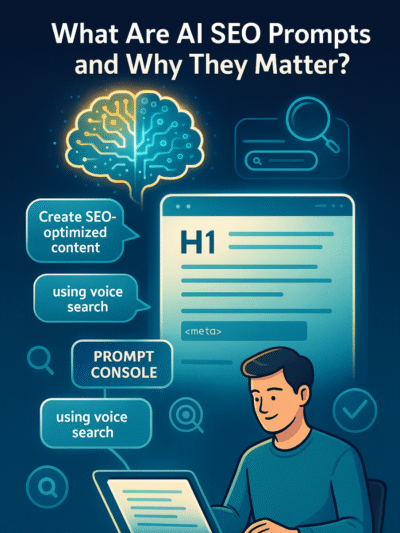
🔍 What Are AI SEO Prompts and Why They Matter
AI SEO prompts guide AI writers to produce content that ranks and remains plagiarism-free.
These prompts shape structure, tone, and keyword placement for better visibility on Google.
This guide gives you a working blueprint that delivers real results using SEO prompts in 2025.
📘 Table of Contents
🧱 Core Structure for AI SEO Prompts
- Use an H1 that includes the keyword AI SEO Prompts.
- Start the article with a compelling hook: “What are AI SEO Prompts?”
- Use a modular structure: intro, multiple H2 sections, internal links, and CTA.
- Specify audience in your prompt (e.g. content strategists, bloggers, entrepreneurs).
- Include bullet points or short sections to improve readability and ranking.
🔊 Using Voice Search Prompts to Increase Visibility
- Prompt: “Answer this: What’s the best AI SEO prompt to use for blog posts?”
- Use short, direct answers that match how users ask questions aloud.
- Insert snippet-style formatting with bullet points or numbered steps.
- Emphasize tone clarity and sentence brevity (under 15 words when possible).
🗣️ AI Voice Search Prompt Guide
This card summarizes the article AI Voice Search Prompts That Ranks Plagiarism-Free Content.
Voice search has reshaped how people ask questions online. To stay competitive, your AI prompts must evolve too.
- Use question-based H2s like “What Are AI SEO Prompts?” or “How do I…?”
- Provide clear, 40–60 word answers at the top of each section.
- Structure your content to mimic natural voice patterns.
- Focus on mobile-friendliness, fast loading, and semantic SEO.
Read the full guide here to see how AI voice prompts can boost your rankings.
🧠 Prompting for Unique & Deep Content (Plagiarism-Free)
- Prompt AI to study what’s already ranking on Google and offer something different.
- Ask for metaphors, analogies, or analogies that don’t exist in other articles.
- Use prompts like: “Rewrite this idea with a fresh example and a better framework.”
- Request original case studies, stats, or real-world applications.
🧩 Best SEO AI Prompts Card
This card reflects the article Best SEO AI Prompts for Creating High-Ranking, Plagiarism-Free Content.
Want prompts that produce SEO-optimized articles with original, ranking content? This resource breaks it down.
- Includes prompt templates for structure, voice, and SEO alignment.
- Shows how to tailor prompts for originality and keyword targeting.
- Includes real examples of plagiarism-free output with Google-rich features.
- Helps you avoid vague or generic prompt results.
Discover prompt strategies that actually work by visiting the full article here.
⚙️ SEO Optimization Tips for Prompts
- Use the keyword “AI SEO Prompts” in at least 33% of subheadings.
- Add it naturally in the introduction, conclusion, and image alt text.
- Instruct AI to output a meta description no longer than 155 characters.
- Prompt for SEO-enhancing elements: featured snippets, FAQs, and schema markup.
🔗 Smart Internal Linking with Prompts
- Use links from your content archive like:
- Prompt: “Add internal links using meaningful anchor text within relevant sentences.”
- Never use “click here”—use keywords or benefit-driven phrases.
✅ Final Thoughts: Mastering AI SEO Prompts
AI SEO prompts are your secret weapon to creating unique, high-ranking content at scale.
Use them to guide tone, structure, depth, and keyword optimization while staying plagiarism-free.
Now you have the answer to ‘What Are AI SEO Prompts and Why They Matter’ apply and test them on your next article, and watch your SEO results grow.
